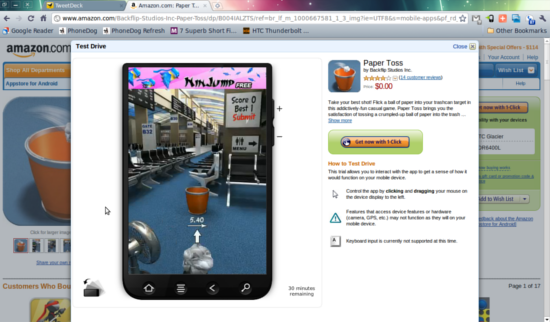
When you think of downloading applications on your new Android phone, you typically launch Android Market and peruse the endless ocean of apps. As of March 22, that may have changed as the Amazon Appstore, in all of its controversial glory, was released to the masses.
When I first heard of the Amazon Appstore for Android, I literally giggled at the thought. Why would we need yet another place to buy apps? How could this app store compete possibly with the Market? Well, it's finally here and I've been using it for two weeks. Here's my take on the Amazon Appstore for Android:

Everyone likes paid apps, nobody likes paying for them. That's the way it goes. But Amazon's Appstore has a few perks in store for users. They offer a daily promotion and give away a paid app for free every day. In the two weeks that I've been using the Amazon's store, I have downloaded (for keeps) $46 in paid apps, completely free of charge. The likeliness of me actually using all of these apps are slim to none, but hey, it can't hurt to have them all, right?
There's no telling how long this will go on, but rest assured this Appstore will remain installed on my phone until it stops. And I will continue to check it daily to get my free app.
In February, the tablet-ready verison of Android made its way to consumer hands with an optimized tablet in tow. The tablet-optimized version of Android Market distinguishes between smartphone and tablet applications and features a rapidly growing section of applications that will properly display on a larger screen. As for Amazon's store, it is not aware of the hardware it is installed on, thus the applications installed will not likely be optimized for tablets.
As the tablet market grows and more Android tablets begin to hit shelves, it's only a matter of time before Amazon updates their market to support the oversized smartphones, but until then, you may want to stick to Android Market on your Honeycomb tablet.

In Android Market, clicking through multiple pages and pop-ups is far too common. If you search for “Twitter” and select Twitter for Android, there are at least two or three more clicks before you can begin downloading the app. In Amazon's Appstore, you search “Twitter,” and you can download the application straight from the search list.
This use of excessive clicks and multiple pages is one of my bigger gripes about Android Market. The updates have made it less taxing, but Amazon's Appstore should be a lesson to ol' Goog.
Amazon's store has one major Achilles' heel. The Appstore has to be sideloaded on a device (downloaded and installed by your own means, not through Market), which means some devices, namely AT&T phones, will not get to enjoy the fruits of Amazon's app store. If you're an AT&T Android user, you will have to root your phone to enable this. A steep price to pay if you're not into rooting, though the free paid apps just might be worth it.
Although it is far less common in the market today, some devices used to come without Android Market installed. Getting it on the device isn't impossible, but it takes some serious effort. With the Amazon Appstore as an option and openly available for any Android device, the days of worrying whether you will have third-party applications or not are over.

A few months ago, Google released a web client for browsing the Android Market. You can browse all of the available applications in the Market from your computer's browser, and install with a few simple clicks. The problem? There was no way to test these applications before installing them. Amazon's Appstore can also be accessed from the browser of your PC, but there is an option to test drive apps before pulling the trigger.
This is a fully functional Android emulator embedded in a web page where you can give applications a 30 minute test run before making your decision. The only downside to this is the peripherals on your computer greatly cripple the experience and can make a popular and fluid app (i.e.: Paper Toss, pictured above) run and feel very choppy and low quality. Amazon had a wonderful idea, but I give them a B- on execution.
This should come as no surprise as it was only launched three weeks ago. It still has its bugs and Amazon appears to be having intermittent problems fairly regularly. The catalog still needs some time to flourish, but it has a broad selection (somewhere in the ballpark of 4000) of applications available. Given the time to iron out the kinks and grow an application base of their own, and this catalog could be a serious contender.